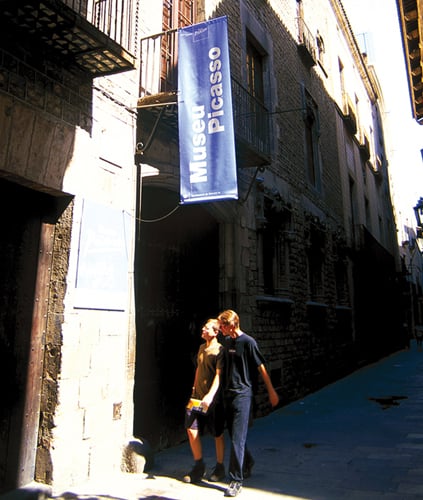Pay homage to the 20th-century’s most acclaimed
artist at this treasure-filled museum. Highlighting Pablo Picasso’s
(1881–1973) formative years, the museum boasts the world’s largest
collection of the artist’s early works. At the tender age of 10, Picasso
was already revealing remarkable artistic tendencies. In 1895, aged 14,
he and his family moved from the town of La Coruña to Barcelona, where
Picasso blossomed as an artist. From precocious schoolbook sketches and
powerful family portraits to selected works from his Blue and Rose
periods, the Museu Picasso offers visitors the rare chance to discover
the artist as he was discovering himself.
C/Montcada 15–23 93 256 30 00
www.museupicasso.bcn.cat
Metro Jaume I Open 10am–8pm Tue–Sun Guided tours: noon Sat & Sun (Catalan), 6pm Thu (Spanish), 4pm Tue & Thu (English); (reservations are essential, email [email protected]) Adm: €9 (includes guided tour); €5.80 (temporary shows); free first Sun of month (permanent collection only) DA
|
|
The museum is made up of five
inter-connected medieval palaces. The permanent collection is arranged
chronologically on the first and second floors of the first three
palaces. Temporary exhibitions – usually showcasing one modern artist –
are housed on the first and second floors of the last two palaces.
|

Entrance, Carrer Montcada
|
After you’ve had your fill of art, duck into the café at the nearby Museu Tèxtil, where you can enjoy a drink or light meal on a graceful outdoor patio.
|
|
|
The Museu Picasso is housed in a Gothic palace complex, replete with leafy courtyards, all of which can be explored.
|
|
Top 10 ExhibitsHombre con boina This
insightful portrait reveals brush strokes – and a subject matter – that
are far beyond a child who has just turned 13. No puppies or racing
cars for the young Picasso; instead, he searched for the oldest men in
the village and painted their portraits. The artist signed this portrait
P Ruiz, because at this time he was still using his father’s last name. Autoretrato con peluca At 14, Picasso painted a series of self-portraits, including Self-portrait with Wig, a whimsical depiction of how he might have looked during the time of his artistic hero, Velázquez. Ciencia y Caridad One of Picasso’s first publicly exhibited paintings was Science and Charity. Picasso’s father posed as the doctor. Menu de Els Quatre Gats Picasso’s
premier Barcelona exhibition was in 1900, held at the Barri Gòtic café,
Els Quatre Gats. The artist’s first commission was the pen-and-ink
drawing of himself and a group of artist friends in top hats, which
graced the menu of this bohemian hang-out. Margot & La Nana Picasso’s Margot is an evocative painting depicting a call-girl as she waits for her next customer, while La Nana captures the defiant expression and stance of a heavily rouged female dwarf dancer. El Loco
The Madman is a
fine example of Picasso’s Blue period. This artistic phase, which
lasted from 1901 to 1904, was characterized by melancholic themes and
sombre colours. Arlequín A lifting of spirits led to Picasso’s Neo-Classical period, typified by paintings like Arlequín, celebrating the light-hearted liberty of circus performers. Caballo corneado The anguished horse in this painting later appears in Guernica,
which reveals the horrors of war. This work gives viewers the chance to
observe the process that went into the creation of Picasso’s most
famous painting. Hombre sentado Works such as Man Sitting confirmed Picasso’s status as the greatest Analytic Cubist painter of the 20th century. Las Meninas Series Picasso’s reverence for Velázquez culminated in this remarkable series of paintings, based on the Velázquez painting
Las Meninas.
|